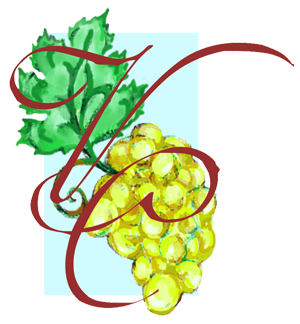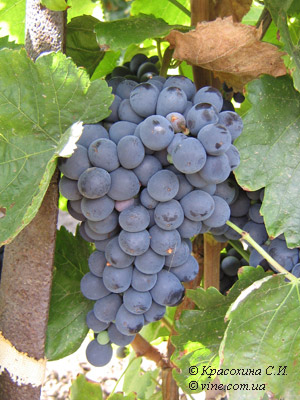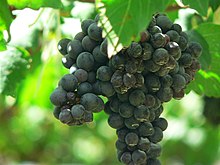Syrah, also known as Shiraz, is a dark-skinned grape variety grown throughout the world and used primarily to produce red wine. DNA profiling in 1999 found Syrah to be the offspring of two obscure grapes from southeastern France, Dureza and Mondeuse blanche.[1] Syrah should not be confused with Petite Sirah, a synonym for Durif, a cross of Syrah with Peloursin dating from 1880.
The style and flavor profile of wines made from Syrah is influenced by the climate where the grapes are grown with moderate climates (such as the northern Rhone Valley and parts of the Walla Walla AVA in Washington State) tending to produce medium to full-bodied wines with medium-plus to high levels of tannins and flavors of blackberry, mint and black pepper notes. In hot climates (such as Crete, and the Barossa Valley and McLaren Vale regions of Australia), Syrah is more consistently full-bodied with softer tannin, jammier fruit and spice notes of liquorice, anise and earthy leather. In many regions the acidity and tannin levels of Syrah allow the wines produced from the grape to have favorable aging potential.[2]
Syrah is used as a varietal and is also blended. Following several years of strong planting, Syrah was estimated in 2004 to be the world's 7th most grown grape at 142,600 hectares (352,000 acres).[3] It can be found throughout the globe from France to New World wine regions such as Chile, South Africa, the Hawke's Bay in New Zealand, California, Washington and in several Australian wine regions such as Barossa, Coonawarra, Hunter Valley, Margaret River and McLaren Vale.[2]
Origin
Syrah has a long documented history in the Rhône region of southeastern France, but it was not known if it had originated in that region. In 1998, a study conducted by Carole Meredith's research group in the Department of Viticulture and Enology at University of California, Davis used DNA typing and extensive grape reference material from the viticultural research station in Montpellier, France to conclude that Syrah was the offspring of the grape varieties Dureza (father) and Mondeuse blanche (mother).[1][4][5][6][7]
Dureza, a dark-skinned grape variety from the Ardèche region in France, has all but disappeared from the vineyards, and the preservation of such varieties is a speciality of Montpellier. Mondeuse blanche is a white grape variety cultivated in the Savoy region, and is still found in very small amounts in that region's vineyards today. Both varieties are somewhat obscure today, and have never achieved anything near Syrah's fame or popularity, and there is no record of them ever having been cultivated at long distances from their present homes. Thus, both of Syrah's parents come from a limited area in southeastern France, very close to northern Rhône. Based on these findings, the researchers have concluded Syrah originated from northern Rhône.[1][7]
The DNA typing leaves no room for doubt in this matter, and the numerous other hypotheses of the grape's origin which have been forwarded during the years all completely lack support in the form of documentary evidence or ampelographic investigations, be it by methods of classical botany or DNA. Instead, they seem to have been based primarily or solely on the name or synonyms of the variety. Because of varying orthography for grape names, especially for old varieties, this is, in general, very thin evidence. Despite this, origins such as Syracuse or the famous Iranian city of Shiraz have been proposed while the genomic studies yet to be done.[7]
The parentage information, however, does not reveal how old the grape variety is, i.e., when the pollination of a Mondeuse blanche vine by Dureza took place, leading to the original Syrah seed plant. In the year AD 77, Pliny the Elder wrote in his Naturalis Historia about the wines of Vienne (which today would be called Côte-Rôtie), where the Allobroges made famous and prized wine from a dark-skinned grape variety that had not existed some 50 years earlier, in Virgil's age.[8] Pliny called the vines of this wine Allobrogica, and it has been speculated that it could be today's Syrah. However, the description of the wine would also fit, for example, Dureza,[1] and Pliny's observation that vines of Allobrogica were resistant to cold is not entirely consistent with Syrah.[8]
The name Syrah
It is called Syrah in its country of origin, France, as well as in the rest of Europe, Argentina, Chile, Uruguay, New Zealand and South Africa.[citation needed] The name Shiraz became popular for this grape variety in Australia, where it has long been established as the most grown dark-skinned variety. In Australia, it was also commonly called Hermitage up to the late 1980s, but since that name is also a French Protected Designation of Origin, this naming practice caused a problem in some export markets and was dropped.
The grape's many other synonyms are used in various parts of the world, including Antourenein noir, Balsamina, Candive, Entournerein, Hignin noir, Marsanne noir, Schiras, Sirac, Syra, Syrac, Serine, and Sereine.[9]
Legends of Syrah's origins come from one of its homonyms, Shiraz.[10] Because Shiraz, Capital of the Persian Empire (modern-day Iran), produced the well-known Shirazi wine,[11] legends claim the Syrah grape originated in Shiraz and then was brought to Rhône. At least two significantly different versions of the myth are reported, giving different accounts of how the variety is supposed to have been brought from Shiraz to Rhône, and differing up to 1,800 years in dating this event. In one version, the Phocaeans could have brought Syrah/Shiraz to their colony around Marseilles (then known as Massilia), which was founded around 600 BC by the Greeks. The grape would then later have made its way to northern Rhône, which was never colonized by the Phocaeans. No documentary evidence exists to back up this legend, and it also requires the variety to later vanish from the Marseilles region without leaving any trace.[8]
The legend connecting Syrah with the city of Shiraz in Iran may, however, be of French origin. James Busby wrote in Journal of a recent visit to the principal vineyards of Spain and France that the 1826 book Œnologie Française, "stated that, according to the tradition of the neighbourhood, the plant [Scyras] was originally brought from Shiraz in Persia, by one of the hermits of the mountain"called Gaspare de Sterimberg.[12]
Since the name Shiraz has been used primarily in Australia in modern times, while the earliest Australian documents use the spelling "Scyras", the name Shiraz has been speculated (among others by Jancis Robinson[9]) to be in fact a so-called "strinization" of Syrah's name via Scyras. However, while the names Shiraz and Hermitage gradually seem to have replaced Scyras in Australia from the mid-19th century, the spelling Shiraz has also been documented in British sources back to at least the 1830s.[12][13][14] So, while the name or spelling Shiraz may be an effect of the English language on a French name, there is no evidence that it actually originated in Australia, although it was definitely the Australian usage and the Australian wines that made the use of this name popular.Another legend of the grape variety's origin, based on the name Syrah, is that it was brought from Syracuse by the legions of Roman Emperor Probus sometime after AD 280. This legend also lacks documentary evidence and is inconsistent with ampelographic findings.
Shiraz wines
Smaller amounts of Syrah are also used in the production of other wine styles, such as rosé wine, fortified wine in Port wine style, and sparkling red wine.[19] While Australian sparkling Shiraz traditionally have had some sweetness, a number of Australian winemakers also make a full-bodied sparkling dry Shiraz, that contains the complexity and sometimes earthy notes that are normally found in still wine.[20]
Due to their concentrated flavours and high tannin content, many premium Syrah wines are at their best after some considerable bottle aging. In exceptional cases, this may be 15 years or longer.
Syrah has one of the highest recommended wine serving temperatures at 18 °C (65 °F).[21]
Taste and flavours
Wines made from Syrah are often powerfully flavoured and full-bodied. The variety produces wines with a wide range of flavor notes, depending on the climate and soils where it is grown, as well as other viticultural practices chosen. Aroma characters can range from violets to berries (usually dark as opposed to red), chocolate, espresso and black pepper. No one aroma can be called "typical" though blackberry and pepper are often noticed. With time in the bottle these "primary" notes are moderated and then supplemented with earthy or savory "tertiary" notes such as leather and truffle. "Secondary" flavor and aroma notes are those associated with several things, generally winemakers' practices (such as oak barrel and yeast treatment).
C13-Norisoprenoids such as 7,8-dihydroionone derivatives, such as megastigmane-3,9-diol and 3-oxo-7,8-dihydro-α-ionol, are found in Shiraz leaves.[2





